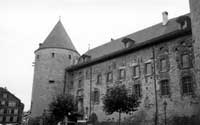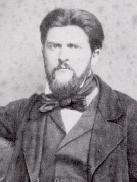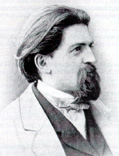| |
| 1863 |
 Draeseke
settles in Yverdon; finishes sketches for the first version of
the cantata on his own text "Der Schwur im Rütli" (WoO
9), for soprano, male chorus and wind orchestra, as well as a
first version of the "Osterscene aus Goethes Faust", (Easter
Scene from Goethe's "Faust") for baritone, mixed choir and orchestra
which only much later appears in reworked form as Op. 39. Draeseke
settles in Yverdon; finishes sketches for the first version of
the cantata on his own text "Der Schwur im Rütli" (WoO
9), for soprano, male chorus and wind orchestra, as well as a
first version of the "Osterscene aus Goethes Faust", (Easter
Scene from Goethe's "Faust") for baritone, mixed choir and orchestra
which only much later appears in reworked form as Op. 39. |
| 1864 |
During
a summer visit in Germany Draeseke begins his text to "Christus".
On his return to Yverdon Draeseke completes his Polonaise in
D major for Piano, WoO 10; moves to Lausanne at the end of the
year and finishes the second part of the "Frithjof" symphonic
poem WoO 7. |
| 1865 |
 Draeseke
attends the premiere of Wagner's "Tristan und Isolde" in
Munich in May.In the hope of a production of "König Sigurd" in
Weimar, Draeseke revises the opera. In August Draeseke undertakes
a second and final revision of the symphonic poem "Julius Caesar",
WoO 6. Draeseke
attends the premiere of Wagner's "Tristan und Isolde" in
Munich in May.In the hope of a production of "König Sigurd" in
Weimar, Draeseke revises the opera. In August Draeseke undertakes
a second and final revision of the symphonic poem "Julius Caesar",
WoO 6.
By year's end he completes the
Lacrimosa, for soloists, chorus and orchestra, published separately
as Op. 10, but later incorporated into the Requiem in B minor,
Op. 22. |
| 1866 |
Draeseke's
only completed work from this year is the Fantasie über Motive
aus Boieldieus "Weisse Dame" (Fantasy on Motives from Boieldieu's "La
Dame blanche" for piano, published as Op. 8). Draeseke witnesses
the collapse of the marriage between Hans and Cosima von Bülow. |
| 1867 |
 Aside
from the Ballad for Cello and Piano, Op. 7, Draeseke produces
the final revision of his Piano Sonata in C# minor, "Sonata quasi
fantasia",Op. 6 and dedicates it to his friend Hans von
Bülow, who ironically never plays the work publicly. A "Valse
Rhapsodie" in E-flat minor and a "Valse-Scherzo" in
C# minor for piano, appear as Opp. 4 and 5 respectively. Aside
from the Ballad for Cello and Piano, Op. 7, Draeseke produces
the final revision of his Piano Sonata in C# minor, "Sonata quasi
fantasia",Op. 6 and dedicates it to his friend Hans von
Bülow, who ironically never plays the work publicly. A "Valse
Rhapsodie" in E-flat minor and a "Valse-Scherzo" in
C# minor for piano, appear as Opp. 4 and 5 respectively. |
| 1868 |
Draeseke
revises his cantata "Der Schwur im Rütli", WoO 9, replacing
the wind orchestra with a normal symphony orchestra. Thereafter
most of the year is spent in Munich where he produces the three
piano pieces which constitute his "Petite Histoire" (Little History),
Op. 9 and the "Valse-Impromptu" in D-flat major, Op.
4, No. 2 for piano. Draeseke begins the composition of his Symphony
No. 1 in G major, Op. 12 and the symphonic prelude to Calderon's "Das
Leben ein Traum" (Life is a Dream), Op. 45. |
| 1869 |
For
most of the year Draeseke is on the traditional grand tour of
an artist, visiting Paris and the Mediterranean lands, including North
African as well as European. Little work is accomplished, though
the finale of the first symphony is sketched. |
| 1870 |
 In
February, Draeseke announces his engagement to one of his Lausanne
students, Louisa de Trey. Because of anti-German sentiment caused
by the Franco-Prussian War, the family intervenes, and the engagement
is canceled and Draeseke continues bachelorhood. Promised performances
of either the "Frithjof" symphonic poem and/or the "Rütli" cantata
at the Beethoven centennial celebrations of the Allgemeine Deutsche
Tonkünstlerverein (General Union of German Musicians) do not
materialize, though Draeseke's Lacrimosa is given its premiere.
In December, Draeseke's father passes away. In
February, Draeseke announces his engagement to one of his Lausanne
students, Louisa de Trey. Because of anti-German sentiment caused
by the Franco-Prussian War, the family intervenes, and the engagement
is canceled and Draeseke continues bachelorhood. Promised performances
of either the "Frithjof" symphonic poem and/or the "Rütli" cantata
at the Beethoven centennial celebrations of the Allgemeine Deutsche
Tonkünstlerverein (General Union of German Musicians) do not
materialize, though Draeseke's Lacrimosa is given its premiere.
In December, Draeseke's father passes away. |
| 1871 |
Draeseke
begins sketching a second symphony, in F major, as well as an "Adventlied" (Song
for Advent) after Rückert for soloists, chorus and orchestra,
his later Op. 30. The Germania Ode after Kleist, WoO 3a, is revised. |
| 1872 |
In
February Draeseke finishes his Ballad in B minor for Cello and
Piano, Op. 11, but his major enterprise for the year is the completion
of the Symphony No. 1 in G major, Op. 12. |
| 1873 |
Draeseke's
Symphony No. 1 in G major, Op. 12 is premiered in Dresden by
his former teacher Julius Rietz. No new works are completed during
the year. |
| 1874 |
Draeseke's major effort for the year is not one of musical composition,
but his essay for the Neue Zeitschrift
für Musik following the death of his colleague and friend Peter
Cornelius, "Peter Cornelius und seine hinterlassenen Werke" (Peter
Cornelius and the Works He Left Behind). |
| 1875 |
Draeseke
writes his first pedagogical treatise, "Anweisung zum kunstegerechten
Modulieren" (Instruction in the Art of Proper Modulation) and
in November he finishes his "Adventlied", Op. 30. |
| 1876 |
 In
February, Draeseke completes his Symphonic Andante in E minor
for Cello and Orchestra, WoO 11 and soon thereafter decides to
leave Switzerland. In
February, Draeseke completes his Symphonic Andante in E minor
for Cello and Orchestra, WoO 11 and soon thereafter decides to
leave Switzerland.
Before moving to his new home, Dresden, Draeseke
completes his Symphony No. 2 in F major, Op. 25 in his hometown
Coburg. His first completed works in Dresden are two piano pieces, "Rote
Blätter fallen" (Red Leaves Are Falling) and "Sternennacht" (Starry
Night) which are later incorporated into the collection "Dämmerungsträume" (Twilight
Reveries), Op. 14, and the Agnus Dei of the now fully projected
Requiem in B minor, Op. 22. |
| Note: |
 : This icon indicates that there is original material regarding this event in the Ebert collection. Click the icon to view those pages. : This icon indicates that there is original material regarding this event in the Ebert collection. Click the icon to view those pages. |
|
|
 Draeseke
settles in Yverdon; finishes sketches for the first version of
the cantata on his own text "Der Schwur im Rütli" (WoO
9), for soprano, male chorus and wind orchestra, as well as a
first version of the "Osterscene aus Goethes Faust", (Easter
Scene from Goethe's "Faust") for baritone, mixed choir and orchestra
which only much later appears in reworked form as Op. 39.
Draeseke
settles in Yverdon; finishes sketches for the first version of
the cantata on his own text "Der Schwur im Rütli" (WoO
9), for soprano, male chorus and wind orchestra, as well as a
first version of the "Osterscene aus Goethes Faust", (Easter
Scene from Goethe's "Faust") for baritone, mixed choir and orchestra
which only much later appears in reworked form as Op. 39. Draeseke
attends the premiere of Wagner's "Tristan und Isolde" in
Munich in May.In the hope of a production of "König Sigurd" in
Weimar, Draeseke revises the opera. In August Draeseke undertakes
a second and final revision of the symphonic poem "Julius Caesar",
WoO 6.
Draeseke
attends the premiere of Wagner's "Tristan und Isolde" in
Munich in May.In the hope of a production of "König Sigurd" in
Weimar, Draeseke revises the opera. In August Draeseke undertakes
a second and final revision of the symphonic poem "Julius Caesar",
WoO 6.
 Aside
from the Ballad for Cello and Piano, Op. 7, Draeseke produces
the final revision of his Piano Sonata in C# minor, "Sonata quasi
fantasia",Op. 6 and dedicates it to his friend Hans von
Bülow, who ironically never plays the work publicly. A "Valse
Rhapsodie" in E-flat minor and a "Valse-Scherzo" in
C# minor for piano, appear as Opp. 4 and 5 respectively.
Aside
from the Ballad for Cello and Piano, Op. 7, Draeseke produces
the final revision of his Piano Sonata in C# minor, "Sonata quasi
fantasia",Op. 6 and dedicates it to his friend Hans von
Bülow, who ironically never plays the work publicly. A "Valse
Rhapsodie" in E-flat minor and a "Valse-Scherzo" in
C# minor for piano, appear as Opp. 4 and 5 respectively.  In
February, Draeseke announces his engagement to one of his Lausanne
students, Louisa de Trey. Because of anti-German sentiment caused
by the Franco-Prussian War, the family intervenes, and the engagement
is canceled and Draeseke continues bachelorhood. Promised performances
of either the "Frithjof" symphonic poem and/or the "Rütli" cantata
at the Beethoven centennial celebrations of the Allgemeine Deutsche
Tonkünstlerverein (General Union of German Musicians) do not
materialize, though Draeseke's Lacrimosa is given its premiere.
In December, Draeseke's father passes away.
In
February, Draeseke announces his engagement to one of his Lausanne
students, Louisa de Trey. Because of anti-German sentiment caused
by the Franco-Prussian War, the family intervenes, and the engagement
is canceled and Draeseke continues bachelorhood. Promised performances
of either the "Frithjof" symphonic poem and/or the "Rütli" cantata
at the Beethoven centennial celebrations of the Allgemeine Deutsche
Tonkünstlerverein (General Union of German Musicians) do not
materialize, though Draeseke's Lacrimosa is given its premiere.
In December, Draeseke's father passes away.